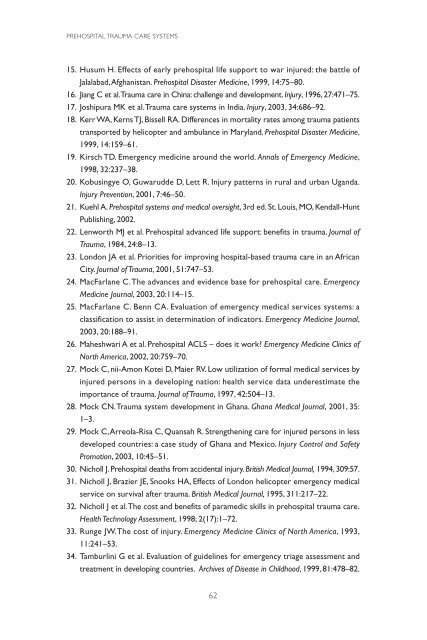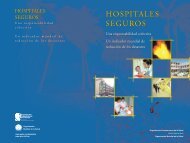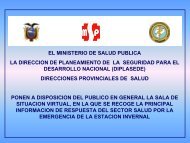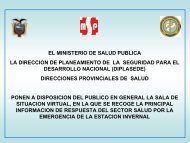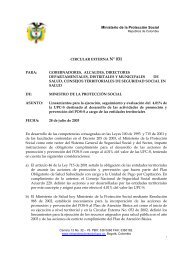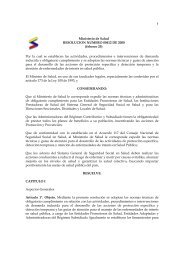Prehospital trauma care systems - World Health Organization
Prehospital trauma care systems - World Health Organization
Prehospital trauma care systems - World Health Organization
Create successful ePaper yourself
Turn your PDF publications into a flip-book with our unique Google optimized e-Paper software.
PREHOSPITAL TRAUMA CARE SYSTEMS<br />
15. Husum H. Effects of early prehospital life support to war injured: the battle of<br />
Jalalabad,Afghanistan. <strong>Prehospital</strong> Disaster Medicine, 1999, 14:75–80.<br />
16. Jiang C et al.Trauma <strong>care</strong> in China: challenge and development. Injury, 1996, 27:471–75.<br />
17. Joshipura MK et al.Trauma <strong>care</strong> <strong>systems</strong> in India. Injury, 2003, 34:686–92.<br />
18. Kerr WA,Kerns TJ, Bissell RA. Differences in mortality rates among <strong>trauma</strong> patients<br />
transported by helicopter and ambulance in Maryland. <strong>Prehospital</strong> Disaster Medicine,<br />
1999, 14:159–61.<br />
19. Kirsch TD. Emergency medicine around the world. Annals of Emergency Medicine,<br />
1998, 32:237–38.<br />
20. Kobusingye O, Guwarudde D, Lett R. Injury patterns in rural and urban Uganda.<br />
Injury Prevention, 2001, 7:46–50.<br />
21. Kuehl A. <strong>Prehospital</strong> <strong>systems</strong> and medical oversight,3rd ed. St. Louis, MO, Kendall-Hunt<br />
Publishing, 2002.<br />
22. Lenworth MJ et al. <strong>Prehospital</strong> advanced life support: benefits in <strong>trauma</strong>. Journal of<br />
Trauma, 1984, 24:8–13.<br />
23. London JA et al. Priorities for improving hospital-based <strong>trauma</strong> <strong>care</strong> in an African<br />
City. Journal of Trauma, 2001, 51:747–53.<br />
24. MacFarlane C.The advances and evidence base for prehospital <strong>care</strong>. Emergency<br />
Medicine Journal, 2003, 20:114–15.<br />
25. MacFarlane C. Benn CA. Evaluation of emergency medical services <strong>systems</strong>: a<br />
classification to assist in determination of indicators. Emergency Medicine Journal,<br />
2003, 20:188–91.<br />
26. Maheshwari A et al. <strong>Prehospital</strong> ACLS – does it work? Emergency Medicine Clinics of<br />
North America, 2002, 20:759–70.<br />
27. Mock C, nii-Amon Kotei D, Maier RV. Low utilization of formal medical services by<br />
injured persons in a developing nation: health service data underestimate the<br />
importance of <strong>trauma</strong>. Journal of Trauma, 1997, 42:504–13.<br />
28. Mock CN.Trauma system development in Ghana. Ghana Medical Journal, 2001, 35:<br />
1–3.<br />
29. Mock C,Arreola-Risa C, Quansah R. Strengthening <strong>care</strong> for injured persons in less<br />
developed countries: a case study of Ghana and Mexico. Injury Control and Safety<br />
Promotion, 2003, 10:45–51.<br />
30. Nicholl J. <strong>Prehospital</strong> deaths from accidental injury. British Medical Journal, 1994, 309:57.<br />
31. Nicholl J, Brazier JE, Snooks HA, Effects of London helicopter emergency medical<br />
service on survival after <strong>trauma</strong>. British Medical Journal, 1995, 311:217–22.<br />
32. Nicholl J et al.The cost and benefits of paramedic skills in prehospital <strong>trauma</strong> <strong>care</strong>.<br />
<strong>Health</strong> Technology Assessment, 1998; 2(17):1–72.<br />
33. Runge JW.The cost of injury. Emergency Medicine Clinics of North America, 1993,<br />
11:241–53.<br />
34. Tamburlini G et al. Evaluation of guidelines for emergency triage assessment and<br />
treatment in developing countries. Archives of Disease in Childhood, 1999, 81:478–82.<br />
62


